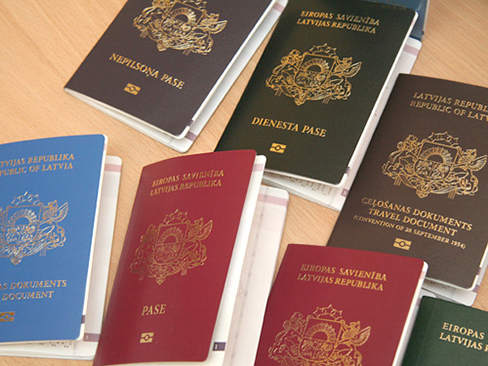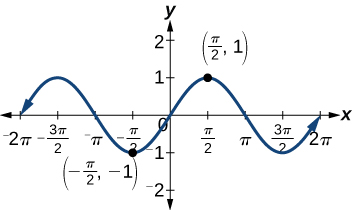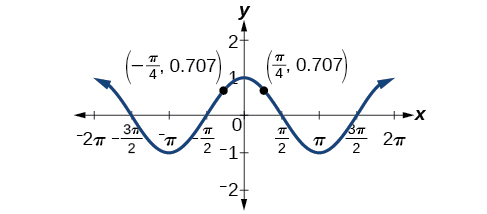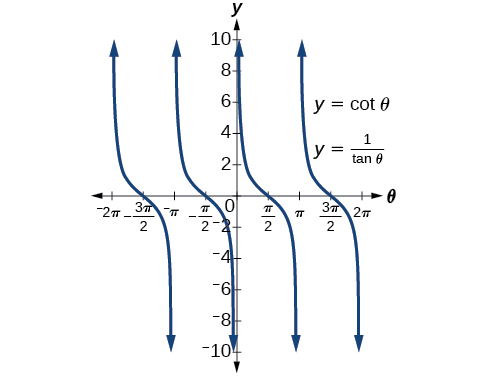4.1: Basic Trigonometric Identities
- Last updated
- Jun 14, 2021
- Save as PDF
- Page ID
- 69149
( \newcommand{\kernel}{\mathrm{null}\,}\)
Learning Objectives
- Verify the fundamental trigonometric identities.
- Simplify trigonometric expressions using algebra and the identities.
In espionage movies, we see international spies with multiple passports, each claiming a different identity. However, we know that each of those passports represents the same person. The trigonometric identities act in a similar manner to multiple passports—there are many ways to represent the same trigonometric expression. Just as a spy will choose an Italian passport when traveling to Italy, we choose the identity that applies to the given scenario when solving a trigonometric equation.

In this section, we will begin an examination of the fundamental trigonometric identities, including how we can verify them and how we can use them to simplify trigonometric expressions.
Verifying the Fundamental Trigonometric Identities
Identities enable us to simplify complicated expressions. They are the basic tools of trigonometry used in solving trigonometric equations, just as factoring, finding common denominators, and using special formulas are the basic tools of solving algebraic equations. In fact, we use algebraic techniques constantly to simplify trigonometric expressions. Basic properties and formulas of algebra, such as the difference of squares formula and the perfect squares formula, will simplify the work involved with trigonometric expressions and equations. We already know that all of the trigonometric functions are related because they all are defined in terms of the unit circle. Consequently, any trigonometric identity can be written in many ways.
To verify the trigonometric identities, we usually start with the more complicated side of the equation and essentially rewrite the expression until it has been transformed into the same expression as the other side of the equation. Sometimes we have to factor expressions, expand expressions, find common denominators, or use other algebraic strategies to obtain the desired result. In this first section, we will work with the fundamental identities: the Pythagorean identities, the even-odd identities, the reciprocal identities, and the quotient identities.
We will begin with the Pythagorean identities (Table 4.1.1), which are equations involving trigonometric functions based on the properties of a right triangle. We have already seen and used the first of these identifies, but now we will also use additional identities.
| sin2θ+cos2θ=1 | 1+cot2θ=csc2θ | 1+tan2θ=sec2θ |
The second and third identities can be obtained by manipulating the first. The identity 1+cot2θ=csc2θ is found by rewriting the left side of the equation in terms of sine and cosine.
Prove: 1+cot2θ=csc2θ
1+cot2θ=(1+cos2sin2)Rewrite the left side=(sin2sin2)+(cos2sin2)Write both terms with the common denominator=sin2+cos2sin2=1sin2=csc2
Similarly,1+tan2θ=sec2θcan be obtained by rewriting the left side of this identity in terms of sine and cosine. This gives
1+tan2θ=1+(sinθcosθ)2Rewrite left side=(cosθcosθ)2+(sinθcosθ)2Write both terms with the common denominator=cos2θ+sin2θcos2θ=1cos2θ=sec2θ
Recall that we determined which trigonometric functions are odd and which are even. The next set of fundamental identities is the set of even-odd identities. The even-odd identities relate the value of a trigonometric function at a given angle to the value of the function at the opposite angle (Table 4.1.2).
| tan(−θ)=−tanθ | sin(−θ)=−sinθ | cos(−θ)=cosθ |
| cot(−θ)=−cotθ | csc(−θ)=−cscθ | sec(−θ)=secθ |
Recall that an odd function is one in which f(−x)=−f(x) for all x in the domain off. f. The sine function is an odd function because sin(−θ)=−sinθ. The graph of an odd function is symmetric about the origin. For example, consider corresponding inputs of π2 and −π2. The output of sin(π2) is opposite the output of sin(−π2). Thus,
sin(π2)=1sin(−π2)=−sin(π2)=−1
This is shown in Figure 4.1.2.

Recall that an even function is one in which
f(−x)=f(x) for all x in the domain of f
The graph of an even function is symmetric about the y-axis. The cosine function is an even function because cos(−θ)=cosθ. For example, consider corresponding inputs π4 and −π4. The output of cos(π4) is the same as the output of cos(−π4). Thus,
cos(−π4)=cos(π4)≈0.707
See Figure 4.1.3.

For all θ in the domain of the sine and cosine functions, respectively, we can state the following:
- Since sin(−θ)=−sinθ,sine is an odd function.
- Since cos(−θ)=cosθ,cosine is an even function.
The other even-odd identities follow from the even and odd nature of the sine and cosine functions. For example, consider the tangent identity,tan(−θ)=−tanθ. We can interpret the tangent of a negative angle as
tan(−θ)=sin(−θ)cos(−θ)=−sinθcosθ=−tanθ.
Tangent is therefore an odd function, which means that tan(−θ)=−tan(θ) for all θ in the domain of the tangent function.
The cotangent identity, cot(−θ)=−cotθ,also follows from the sine and cosine identities. We can interpret the cotangent of a negative angle as
cot(−θ)=cos(−θ)sin(−θ)=cosθ−sinθ=−cotθ.
Cotangent is therefore an odd function, which means that cot(−θ)=−cot(θ) for all θ in the domain of the cotangent function.
The cosecant function is the reciprocal of the sine function, which means that the cosecant of a negative angle will be interpreted as
csc(−θ)=1sin(−θ)=1−sinθ=−cscθ.
The cosecant function is therefore odd.
Finally, the secant function is the reciprocal of the cosine function, and the secant of a negative angle is interpreted as
sec(−θ)=1cos(−θ)=1cosθ=secθ.
The secant function is therefore even.
To sum up, only two of the trigonometric functions, cosine and secant, are even. The other four functions are odd, verifying the even-odd identities.
The next set of fundamental identities is the set of reciprocal identities, which, as their name implies, relate trigonometric functions that are reciprocals of each other. (Table 4.1.3). Recall that we first encountered these identities when defining trigonometric functions from right angles in Right Angle Trigonometry.
| sinθ=1cscθ | cscθ=1sinθ |
| cosθ=1secθ | secθ=1cosθ |
| tanθ=1cotθ | cotθ=1tanθ |
The final set of identities is the set of quotient identities, which define relationships among certain trigonometric functions and can be very helpful in verifying other identities (Table 4.1.4).
| tanθ=sinθcosθ | cotθ=cosθsinθ |
The reciprocal and quotient identities are derived from the definitions of the basic trigonometric functions.
SUMMARIZING TRIGONOMETRIC IDENTITIES
The Pythagorean identities are based on the properties of a right triangle.
cos2θ+sin2θ=1
1+cot2θ=csc2θ
1+tan2θ=sec2θ
The even-odd identities relate the value of a trigonometric function at a given angle to the value of the function at the opposite angle.
tan(−θ)=−tanθ
cot(−θ)=−cotθ
sin(−θ)=−sinθ
csc(−θ)=−cscθ
cos(−θ)=cosθ
sec(−θ)=secθ
The reciprocal identities define reciprocals of the trigonometric functions.
sinθ=1cscθ
cosθ=1secθ
tanθ=1cotθ
cscθ=1sinθ
secθ=1cosθ
cotθ=1tanθ
The quotient identities define the relationship among the trigonometric functions.
tanθ=sinθcosθ
cotθ=cosθsinθ
Example 4.1.1: Graphing the Equations of an Identity
Graph both sides of the identity cotθ=1tanθ. In other words, on the graphing calculator, graph y=cotθ and y=1tanθ.
Solution
See Figure 4.1.4.

Analysis
We see only one graph because both expressions generate the same image. One is on top of the other. This is a good way to prove any identity. If both expressions give the same graph, then they must be identities.
How to: Given a trigonometric identity, verify that it is true.
- Work on one side of the equation. It is usually better to start with the more complex side, as it is easier to simplify than to build.
- Look for opportunities to factor expressions, square a binomial, or add fractions.
- Noting which functions are in the final expression, look for opportunities to use the identities and make the proper substitutions.
- If these steps do not yield the desired result, try converting all terms to sines and cosines.
Example 4.1.2: Verifying a Trigonometric Identity
Verify tanθcosθ=sinθ.
Solution
We will start on the left side, as it is the more complicated side:
tanθcosθ=(sinθcosθ)cosθ=sinθ
Analysis
This identity was fairly simple to verify, as it only required writing tanθ in terms of sinθ and cosθ.
Exercise 4.1.1
Verify the identity cscθcosθtanθ=1.
- Answer
-
cscθcosθtanθ=(1sinθ)cosθ(sinθcosθ)=cosθsinθ(sinθcosθ)=sinθcosθsinθcosθ=1
Example 4.1.3A: Verifying the Equivalency Using the Even-Odd Identities
Verify the following equivalency using the even-odd identities:
(1+sinx)[1+sin(−x)]=cos2x
Solution
Working on the left side of the equation, we have
(1+sinx)[1+sin(−x)]=(1+sinx)(1−sinx)
Since
sin(−x)=−sinx[5pt]=1−sin2xDifference of squares[5pt]=cos2xcos2x=1−sin2x
Example 4.1.3B: Verifying a Trigonometric Identity Involving sec2θ
Verify the identity sec2θ−1sec2θ=sin2θ
Solution
As the left side is more complicated, let’s begin there.
sec2θ−1sec2θ=(tan2θ+1)−1sec2θsec2θ=tan2θ+1=tan2θsec2θ=tan2θ(1sec2θ)=tan2θ(cos2θ)cos2θ=1sec2θ=(sin2θcos2θ)tan2θ=sin2θcos2θ=sin2θ
There is more than one way to verify an identity. Here is another possibility. Again, we can start with the left side.
sec2θ−1sec2θ=sec2θsec2θ−1sec2θ=1−cos2θ=sin2θ
Analysis
In the first method, we used the identity sec2θ=tan2θ+1 and continued to simplify. In the second method, we split the fraction, putting both terms in the numerator over the common denominator. This problem illustrates that there are multiple ways we can verify an identity. Employing some creativity can sometimes simplify a procedure. As long as the substitutions are correct, the answer will be the same.
Exercise 4.1.2
Show that cotθcscθ=cosθ.
- Answer
-
cotθcscθ=cosθsinθ1sinθ=cosθsinθ⋅sinθ1=cosθ
Example 4.1.4: Creating and Verifying an Identity
Create an identity for the expression 2tanθsecθ by rewriting strictly in terms of sine.
Solution
There are a number of ways to begin, but here we will use the quotient and reciprocal identities to rewrite the expression:
2tanθsecθ=2(sinθcosθ)(1cosθ)=2sinθcos2θ=2sinθ1−sin2θSubstitute 1−sin2θ for cos2θ
Thus,
2tanθsecθ=2sinθ1−sin2θ
Example 4.1.5: Verifying an Identity Using Algebra and Even/Odd Identities
Verify the identity:
sin2(−θ)−cos2(−θ)sin(−θ)−cos(−θ)=cosθ−sinθ
Solution
Let’s start with the left side and simplify:
sin2(−θ)−cos2(−θ)sin(−θ)−cos(−θ)=[sin(−θ)]2−[cos(−θ)]2sin(−θ)−cos(−θ)=(−sinθ)2−(cosθ)2−sinθ−cosθ,sin(−x)=−sin x and cos(−x)=cos x=(sinθ)2−(cosθ)2−sinθ−cosθDifference of squares=(sinθ−cosθ)(sinθ+cosθ)−(sinθ+cosθ)=cosθ−sinθ
Exercise 4.1.3
Verify the identity sin2θ−1tanθsinθ−tanθ=sinθ+1tanθ.
- Answer
-
sin2θ−1tanθsinθ−tanθ=(sinθ+1)(sinθ−1)tanθ(sinθ−1)=sinθ+1tanθ
Example 4.1.6: Verifying an Identity Involving Cosines and Cotangents
Verify the identity: (1−cos2x)(1+cot2x)=1.
Solution
(1−cos2x)(1+cot2x)=(1−cos2x)(1+cos2xsin2x)=(1−cos2x)(sin2xsin2x+cos2xsin2x)Find the common denominator=(1−cos2x)(sin2x+cos2xsin2x)=(sin2x)(1sin2x)=1
Using Algebra to Simplify Trigonometric Expressions
We have seen that algebra is very important in verifying trigonometric identities, but it is just as critical in simplifying trigonometric expressions before solving. Being familiar with the basic properties and formulas of algebra, such as the difference of squares formula, the perfect square formula, or substitution, will simplify the work involved with trigonometric expressions and equations.
For example, the equation (sinx+1)(sinx−1)=0 resembles the equation (x+1)(x−1)=0, which uses the factored form of the difference of squares. Using algebra makes finding a solution straightforward and familiar. We can set each factor equal to zero and solve. This is one example of recognizing algebraic patterns in trigonometric expressions or equations.
Another example is the difference of squares formula, a2−b2=(a−b)(a+b), which is widely used in many areas other than mathematics, such as engineering, architecture, and physics. We can also create our own identities by continually expanding an expression and making the appropriate substitutions. Using algebraic properties and formulas makes many trigonometric equations easier to understand and solve.
Example 4.1.7A: Writing the Trigonometric Expression as an Algebraic Expression
Write the following trigonometric expression as an algebraic expression: 2cos2θ+cosθ−1.
Solution
Notice that the pattern displayed has the same form as a standard quadratic expression,ax2+bx+c. Letting cosθ=x,we can rewrite the expression as follows:
2x2+x−1
This expression can be factored as (2x+1)(x−1). If it were set equal to zero and we wanted to solve the equation, we would use the zero factor property and solve each factor for x. At this point, we would replace x with cosθ and solve for θ.
Example 4.1.7B: Rewriting a Trigonometric Expression Using the Difference of Squares
Rewrite the trigonometric expression using the difference of squares: 4cos2θ−1.
Solution
Notice that both the coefficient and the trigonometric expression in the first term are squared, and the square of the number 1 is 1. This is the difference of squares.
4cos2θ−1=(2cosθ)2−1=(2cosθ−1)(2cosθ+1)
Analysis
If this expression were written in the form of an equation set equal to zero, we could solve each factor using the zero factor property. We could also use substitution like we did in the previous problem and let cosθ=x, rewrite the expression as 4x2−1, and factor (2x−1)(2x+1). Then replace x with cosθ and solve for the angle.
Exercise 4.1.4
Rewrite the trigonometric expression using the difference of squares: 25−9sin2θ.
- Answer
-
This is a difference of squares formula: 25−9sin2θ=(5−3sinθ)(5+3sinθ).
Example 4.1.8: Simplify by Rewriting and Using Substitution
Simplify the expression by rewriting and using identities:
csc2θ−cot2θ
Solution
We can start with the Pythagorean identity.
1+cot2θ=csc2θNow we can simplify by substituting 1+cot2θ for csc2θcsc2θ−cot2θ=1+cot2θ−cot2θ=1
Exercise 4.1.5
Use algebraic techniques to verify the identity: cosθ1+sinθ=1−sinθcosθ.
(Hint: Multiply the numerator and denominator on the left side by 1−sinθ.)
- Answer
-
cosθ1+sinθ(1−sinθ1−sinθ)=cosθ(1−sinθ)1−sin2θ=cosθ(1−sinθ)cos2θ=1−sinθcosθ
Media
Access these online resources for additional instruction and practice with the fundamental trigonometric identities.
- Fundamental Trigonometric Identities
- Verifying Trigonometric Identities
Key Equations
| Pythagorean identities |
cos2θ+sin2θ=1 1+cot2θ=csc2θ 1+tan2θ=sec2θ |
| Even-odd identities |
tan(−θ)=−tanθ cot(−θ)=−cotθ sin(−θ)=−sinθ csc(−θ)=−cscθ cos(−θ)=cosθ sec(−θ)=secθ |
| Reciprocal identities |
sinθ=1cscθ cosθ=1secθ tanθ=1cotθ cscθ=1sinθ secθ=1cosθ cotθ=1tanθ |
| Quotient identities |
tanθ=sinθcosθ cotθ=cosθsinθ |
Key Concepts
- There are multiple ways to represent a trigonometric expression. Verifying the identities illustrates how expressions can be rewritten to simplify a problem.
- Graphing both sides of an identity will verify it. See Example 4.1.1.
- Simplifying one side of the equation to equal the other side is another method for verifying an identity. See Example 4.1.2 and Example 4.1.3.
- The approach to verifying an identity depends on the nature of the identity. It is often useful to begin on the more complex side of the equation. See Example 4.1.4.
- We can create an identity and then verify it. See Example 4.1.5.
- Verifying an identity may involve algebra with the fundamental identities. See Example 4.1.6 and Example 4.1.7.
- Algebraic techniques can be used to simplify trigonometric expressions. We use algebraic techniques throughout this text, as they consist of the fundamental rules of mathematics. See Example 4.1.8, Example 4.1.9, and Example 4.1.10.


